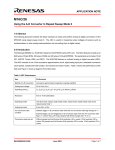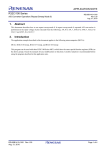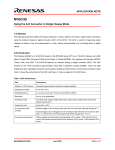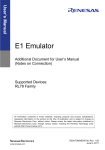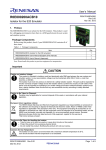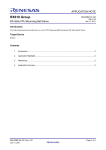Download M16C/5M A/D Converter Using Repeat Sweep Mode 0
Transcript
APPLICATION NOTE M16C/5M Group A/D Converter Using Repeat Sweep Mode 0 1. R01AN0144EJ0100 Rev.1.00 Mar 15, 2011 Abstract This document describes the setting procedure to use the A/D converter in repeat sweep mode 0. 2. Introduction The application example described in this document applies to the following microcomputer (MCU): • MCU: M16C/5M Group This application note can be used with other M16C Family MCUs which have the same special function registers (SFRs) as the above group. Check the manual for any modifications to functions. Careful evaluation is recommended before using the sample code described in this application note. R01AN0144EJ0100 Rev.1.00 Mar 15, 2011 Page 1 of 7 M16C/5M Group 3. A/D Converter Using Repeat Sweep Mode 0 Operation in Repeat Sweep Mode 0 This section describes operation when using the A/D converter in repeat sweep mode 0 with a software trigger. (1) When the ADST bit in the ADCON0 register is set to 1 (A/D conversion start), A/D conversion starts. The input voltage of the AN0 pin is converted. (2) After completing A/D conversion of the AN0 pin, the value in the successive conversion register (conversion result) is transferred to the AD0 register. A/D conversions for selected analog input pins are continuously performed in order. Every time A/D conversion for a pin is completed, the conversion result is transferred to the ADi (i = 0 to 7) register corresponding to the pin. (3) When A/D conversion for all selected analog input pins is completed, A/D conversion is started again from the AN0 pin. The IR bit in the ADIC register does not become 1 (interrupt requested). (4) A/D conversion does not stop until the ADST bit in the ADCON0 register is set to 0 (A/D conversion stop) by a program. Figure 3.1 shows Operation Timing in Repeat Sweep Mode 0. (1) Start A/D conversion (convert input voltage of AN0) (2) After completing A/D conversion of AN0, start A/D conversion of AN1. (3) After completing A/D conversion of selected analog input pin, start A/D conversion again from AN0. Conversion time Conversion time Conversion time (4) Stop A/D conversion φAD Set to 1 by a program Set to 0 by a program 1 ADST bit 0 Conversion result AD0 register (A/D conversion value of AN0) AD1 register (A/D conversion value of AN1) Undefined Conversion result Figure 3.1 Conversion result Undefined ADi register (A/D conversion value of ANi) Undefined Undefined Undefined Conversion result Undefined Operation Timing in Repeat Sweep Mode 0 R01AN0144EJ0100 Rev.1.00 Mar 15, 2011 Page 2 of 7 M16C/5M Group 4. A/D Converter Using Repeat Sweep Mode 0 A/D Conversion Time This section describes how to calculate A/D conversion time. 4.1 A/D Conversion Cycle Table 4.1 shows Cycles of A/D Conversion Item. A/D conversion time is described below. Start processing time depends on which φAD is selected. A/D conversion starts after the start processing time elapses by setting the ADST bit in the ADCON0 register to 1 (A/D conversion start). When reading the ADST bit before starting A/D conversion, 0 (A/D conversion stop) is read. In repeat sweep mode 0, inter-execution processing time is inserted between A/D conversions. • Repeat sweep mode 0: Start processing time + (A/D conversion execution time + inter-execution processing time + A/D conversion execution time + inter-execution processing time + ...) Table 4.1 Cycles of A/D Conversion Item A/D Conversion Item φAD = fAD φAD = fAD divided by 2 φAD = fAD divided by 3 Start processing time φAD = fAD divided by 4 φAD = fAD divided by 6 φAD = fAD divided by 12 A/D conversion execution Open-circuit detection disabled time Open-circuit detection enabled Inter-execution processing time End processing time 4.2 Number of Cycles 1 to 2 cycles of fAD 2 to 3 cycles of fAD 3 to 4 cycles of fAD 3 to 4 cycles of fAD 4 to 5 cycles of fAD 7 to 8 cycles of fAD 40 cycles of φAD 42 cycles of φAD 1 cycle of φAD 2 to 3 cycles of fAD A/D Operation Clock Frequencies Table 4.2 lists the A/D Operation Clock Frequencies. Table 4.2 A/D Operation Clock Frequencies (1) VCC = AVCC = VREF = 3.0 to 5.5 V, VSS = AVSS = 0 V at Topr = -40°C to 85°C (for J version) / -40°C to 125°C (for K version) unless otherwise specified. Symbol φAD Parameter A/D operating clock frequency Measuring Condition Standard Min. Typ. Max. Unit 4.0 V ≤ VCC ≤ 5.5 V 2 25 MHz 3.2 V ≤ VCC ≤ 4.0 V 2 16 MHz 3.0 V ≤ VCC ≤ 3.2 V 2 10 MHz Note: 1. Use when AVCC = VCC. R01AN0144EJ0100 Rev.1.00 Mar 15, 2011 Page 3 of 7 M16C/5M Group 5. A/D Converter Using Repeat Sweep Mode 0 Settings Figure 5.1 shows the Setting Procedure When Using Repeat Sweep Mode 0. Refer to the User’s Manual: Hardware for details on registers. Setting for repeat sweep mode 0 Set an analog input pin Set the ADCON2 register Set the ADCON0 register Set the ADCON1 register Wait for one or more cycles of φAD Start A/D conversion Set a pin to be used for analog input to input mode. Select A/D converter functions b2, b1: Select A/D input group b4: Select an operation clock frequency Select A/D converter functions b4, b3: Set to 11b when using repeat sweep mode 0 b5: Select an A/D conversion start trigger b6: A/D conversion start flag b7: Select an operation clock frequency Select A/D converter functions b1-b0: Select A/D sweep pins b2: Set to 0 when using repeat sweep mode 0 b4: Select an operation clock frequency b5: Set to 1 when enabling A/D conversion Wait time until the A/D converter is ready for a conversion when setting the ADSTBY bit from 0 to 1. Generate the A/D conversion start trigger. END Figure 5.1 Setting Procedure When Using Repeat Sweep Mode 0 R01AN0144EJ0100 Rev.1.00 Mar 15, 2011 Page 4 of 7 M16C/5M Group 6. A/D Converter Using Repeat Sweep Mode 0 Sample Code A sample code can be downloaded from the Renesas Electronics website. To download, click “Application Notes” in the left-hand side menu of the M16C Family page. 6.1 Sample Code Operation In repeat sweep mode 0, functions listed in Table 6.1 can be selected. The settings used in the sample code are marked with “9” in the table. The sample code operation is as follows; set the CPU clock as the main clock with no division by executing functions for CPU initialization, transition from 125 kHz on-chip oscillator mode to high-speed mode, then execute the function for A/D conversion in repeat sweep mode 0. Refer to 6.2 Function Tables for details on functions. Table 6.1 Sample Code Settings Functions Settings 9 f1 f1 divided by 2 f1 divided by 3 f1 divided by 4 f1 divided by 6 Operating clock φAD f1 divided by 12 fOCO40M divided by 2 fOCO40M divided by 3 fOCO40M divided by 4 fOCO40M divided by 6 fOCO40M divided by 12 A/D conversion start conditions 9 Software trigger Trigger by ADTRG 9 AN0 to AN7 AN0_0 to AN0_7 Analog input group (1) AN2_0 to AN2_7 AN3_0 to AN3_2 AN0 to AN1 (2 pins) AN0 to AN3 (4 pins) A/D sweep pin (1) A/D open-circuit detection assist function AN0 to AN5 (6 pins) 9 AN0 to AN7 (8 pins) 9 Not used Note: 1. The number of usable analog input pins varies depending on pin numbers of the package used. Refer to the “A/D Converter” in the User’s Manual: Hardware for details. R01AN0144EJ0100 Rev.1.00 Mar 15, 2011 Page 5 of 7 M16C/5M Group 6.2 A/D Converter Using Repeat Sweep Mode 0 Function Tables Function Tables for This Document Declaration void ad_repeatsweep0(void) Outline A/D conversion in repeat sweep mode 0 Argument None Variable None Returned value None Function Set the A/D converter to repeat sweep mode 0 and set the functions as marked in Table 6.1. Set an analog input pin to AN0, P10 to input mode. Generate a software trigger and start A/D conversion of the voltage input at pins AN0 to AN7. Declaration unsigned short read_ad_register(unsigned char ch) Outline Read A/D register Argument unsigned char ch Variable None Returned value unsigned short read_ad_data Function Read the A/D register selected with the unsigned char ch argument. Then return the read value as a returned value. Select the A/D register to be read Value read from the A/D register Other Function Tables Declaration void mcu_init(void) Outline CPU initialization Argument None Variable None Returned value None Function Set to single-chip mode. Switch the CPU clock from 125 kHz on-chip oscillator mode divided-by-8 to 125 kHz on-chip oscillator mode divided-by-1. Declaration void highspeed_from_foco125k(void) Outline Transition from 125 kHz on-chip oscillator mode to high-speed mode Argument None Variable None Returned value None Function Switch the CPU clock from 125 kHz on-chip oscillator mode (fOCO-S divided by 1) to high-speed mode. R01AN0144EJ0100 Rev.1.00 Mar 15, 2011 Page 6 of 7 M16C/5M Group 7. A/D Converter Using Repeat Sweep Mode 0 Reference Documents M16C/5M Group User’s Manual: Hardware Rev.1.01 The latest version can be downloaded from the Renesas Electronics website. Technical Update/Technical News The latest information can be downloaded from the Renesas Electronics website. M16C Series/R8C Family C Compiler Package V.5.45 C Compiler User’s Manual Rev.3.00 The latest version can be downloaded from the Renesas Electronics website. Website and Support Renesas Electronics website http://www.renesas.com/ Inquiries http://www.renesas.com/inquiry R01AN0144EJ0100 Rev.1.00 Mar 15, 2011 Page 7 of 7 M16C/5M Group Using Repeat Sweep Mode 0 Revision History Rev. Date 1.00 2011.03.15 Page — Description Summary First edition issued All trademarks and registered trademarks are the property of their respective owners. A-1 General Precautions in the Handling of MPU/MCU Products The following usage notes are applicable to all MPU/MCU products from Renesas. For detailed usage notes on the products covered by this manual, refer to the relevant sections of the manual. If the descriptions under General Precautions in the Handling of MPU/MCU Products and in the body of the manual differ from each other, the description in the body of the manual takes precedence. 1. Handling of Unused Pins Handle unused pins in accord with the directions given under Handling of Unused Pins in the manual. The input pins of CMOS products are generally in the high-impedance state. In operation with an unused pin in the open-circuit state, extra electromagnetic noise is induced in the vicinity of LSI, an associated shoot-through current flows internally, and malfunctions occur due to the false recognition of the pin state as an input signal become possible. Unused pins should be handled as described under Handling of Unused Pins in the manual. 2. Processing at Power-on The state of the product is undefined at the moment when power is supplied. The states of internal circuits in the LSI are indeterminate and the states of register settings and pins are undefined at the moment when power is supplied. In a finished product where the reset signal is applied to the external reset pin, the states of pins are not guaranteed from the moment when power is supplied until the reset process is completed. In a similar way, the states of pins in a product that is reset by an on-chip power-on reset function are not guaranteed from the moment when power is supplied until the power reaches the level at which resetting has been specified. 3. Prohibition of Access to Reserved Addresses Access to reserved addresses is prohibited. The reserved addresses are provided for the possible future expansion of functions. Do not access these addresses; the correct operation of LSI is not guaranteed if they are accessed. 4. Clock Signals After applying a reset, only release the reset line after the operating clock signal has become stable. When switching the clock signal during program execution, wait until the target clock signal has stabilized. When the clock signal is generated with an external resonator (or from an external oscillator) during a reset, ensure that the reset line is only released after full stabilization of the clock signal. Moreover, when switching to a clock signal produced with an external resonator (or by an external oscillator) while program execution is in progress, wait until the target clock signal is stable. 5. Differences between Products Before changing from one product to another, i.e. to one with a different part number, confirm that the change will not lead to problems. The characteristics of MPU/MCU in the same group but having different part numbers may differ because of the differences in internal memory capacity and layout pattern. When changing to products of different part numbers, implement a system-evaluation test for each of the products. Notice 1. All information included in this document is current as of the date this document is issued. Such information, however, is subject to change without any prior notice. Before purchasing or using any Renesas Electronics products listed herein, please confirm the latest product information with a Renesas Electronics sales office. Also, please pay regular and careful attention to additional and different information to be disclosed by Renesas Electronics such as that disclosed through our website. 2. Renesas Electronics does not assume any liability for infringement of patents, copyrights, or other intellectual property rights of third parties by or arising from the use of Renesas Electronics products or technical information described in this document. No license, express, implied or otherwise, is granted hereby under any patents, copyrights or other intellectual property rights of Renesas Electronics or others. 3. You should not alter, modify, copy, or otherwise misappropriate any Renesas Electronics product, whether in whole or in part. 4. Descriptions of circuits, software and other related information in this document are provided only to illustrate the operation of semiconductor products and application examples. You are fully responsible for the incorporation of these circuits, software, and information in the design of your equipment. Renesas Electronics assumes no responsibility for any losses incurred by you or third parties arising from the use of these circuits, software, or information. 5. When exporting the products or technology described in this document, you should comply with the applicable export control laws and regulations and follow the procedures required by such laws and regulations. You should not use Renesas Electronics products or the technology described in this document for any purpose relating to military applications or use by the military, including but not limited to the development of weapons of mass destruction. Renesas Electronics products and technology may not be used for or incorporated into any products or systems whose manufacture, use, or sale is prohibited under any applicable domestic or foreign laws or regulations. 6. Renesas Electronics has used reasonable care in preparing the information included in this document, but Renesas Electronics does not warrant that such information is error free. Renesas Electronics 7. Renesas Electronics products are classified according to the following three quality grades: "Standard", "High Quality", and "Specific". The recommended applications for each Renesas Electronics product assumes no liability whatsoever for any damages incurred by you resulting from errors in or omissions from the information included herein. depends on the product's quality grade, as indicated below. You must check the quality grade of each Renesas Electronics product before using it in a particular application. You may not use any Renesas Electronics product for any application categorized as "Specific" without the prior written consent of Renesas Electronics. Further, you may not use any Renesas Electronics product for any application for which it is not intended without the prior written consent of Renesas Electronics. Renesas Electronics shall not be in any way liable for any damages or losses incurred by you or third parties arising from the use of any Renesas Electronics product for an application categorized as "Specific" or for which the product is not intended where you have failed to obtain the prior written consent of Renesas Electronics. The quality grade of each Renesas Electronics product is "Standard" unless otherwise expressly specified in a Renesas Electronics data sheets or data books, etc. "Standard": Computers; office equipment; communications equipment; test and measurement equipment; audio and visual equipment; home electronic appliances; machine tools; personal electronic equipment; and industrial robots. "High Quality": Transportation equipment (automobiles, trains, ships, etc.); traffic control systems; anti-disaster systems; anti-crime systems; safety equipment; and medical equipment not specifically designed for life support. "Specific": Aircraft; aerospace equipment; submersible repeaters; nuclear reactor control systems; medical equipment or systems for life support (e.g. artificial life support devices or systems), surgical implantations, or healthcare intervention (e.g. excision, etc.), and any other applications or purposes that pose a direct threat to human life. 8. You should use the Renesas Electronics products described in this document within the range specified by Renesas Electronics, especially with respect to the maximum rating, operating supply voltage range, movement power voltage range, heat radiation characteristics, installation and other product characteristics. Renesas Electronics shall have no liability for malfunctions or damages arising out of the use of Renesas Electronics products beyond such specified ranges. 9. Although Renesas Electronics endeavors to improve the quality and reliability of its products, semiconductor products have specific characteristics such as the occurrence of failure at a certain rate and malfunctions under certain use conditions. Further, Renesas Electronics products are not subject to radiation resistance design. Please be sure to implement safety measures to guard them against the possibility of physical injury, and injury or damage caused by fire in the event of the failure of a Renesas Electronics product, such as safety design for hardware and software including but not limited to redundancy, fire control and malfunction prevention, appropriate treatment for aging degradation or any other appropriate measures. Because the evaluation of microcomputer software alone is very difficult, please evaluate the safety of the final products or system manufactured by you. 10. Please contact a Renesas Electronics sales office for details as to environmental matters such as the environmental compatibility of each Renesas Electronics product. Please use Renesas Electronics products in compliance with all applicable laws and regulations that regulate the inclusion or use of controlled substances, including without limitation, the EU RoHS Directive. Renesas Electronics assumes no liability for damages or losses occurring as a result of your noncompliance with applicable laws and regulations. 11. This document may not be reproduced or duplicated, in any form, in whole or in part, without prior written consent of Renesas Electronics. 12. Please contact a Renesas Electronics sales office if you have any questions regarding the information contained in this document or Renesas Electronics products, or if you have any other inquiries. (Note 1) "Renesas Electronics" as used in this document means Renesas Electronics Corporation and also includes its majority-owned subsidiaries. (Note 2) "Renesas Electronics product(s)" means any product developed or manufactured by or for Renesas Electronics. http://www.renesas.com SALES OFFICES Refer to "http://www.renesas.com/" for the latest and detailed information. Renesas Electronics America Inc. 2880 Scott Boulevard Santa Clara, CA 95050-2554, U.S.A. Tel: +1-408-588-6000, Fax: +1-408-588-6130 Renesas Electronics Canada Limited 1101 Nicholson Road, Newmarket, Ontario L3Y 9C3, Canada Tel: +1-905-898-5441, Fax: +1-905-898-3220 Renesas Electronics Europe Limited Dukes Meadow, Millboard Road, Bourne End, Buckinghamshire, SL8 5FH, U.K Tel: +44-1628-585-100, Fax: +44-1628-585-900 Renesas Electronics Europe GmbH Arcadiastrasse 10, 40472 Düsseldorf, Germany Tel: +49-211-65030, Fax: +49-211-6503-1327 Renesas Electronics (China) Co., Ltd. 7th Floor, Quantum Plaza, No.27 ZhiChunLu Haidian District, Beijing 100083, P.R.China Tel: +86-10-8235-1155, Fax: +86-10-8235-7679 Renesas Electronics (Shanghai) Co., Ltd. Unit 204, 205, AZIA Center, No.1233 Lujiazui Ring Rd., Pudong District, Shanghai 200120, China Tel: +86-21-5877-1818, Fax: +86-21-6887-7858 / -7898 Renesas Electronics Hong Kong Limited Unit 1601-1613, 16/F., Tower 2, Grand Century Place, 193 Prince Edward Road West, Mongkok, Kowloon, Hong Kong Tel: +852-2886-9318, Fax: +852 2886-9022/9044 Renesas Electronics Taiwan Co., Ltd. 7F, No. 363 Fu Shing North Road Taipei, Taiwan Tel: +886-2-8175-9600, Fax: +886 2-8175-9670 Renesas Electronics Singapore Pte. Ltd. 1 harbourFront Avenue, #06-10, keppel Bay Tower, Singapore 098632 Tel: +65-6213-0200, Fax: +65-6278-8001 Renesas Electronics Malaysia Sdn.Bhd. Unit 906, Block B, Menara Amcorp, Amcorp Trade Centre, No. 18, Jln Persiaran Barat, 46050 Petaling Jaya, Selangor Darul Ehsan, Malaysia Tel: +60-3-7955-9390, Fax: +60-3-7955-9510 Renesas Electronics Korea Co., Ltd. 11F., Samik Lavied' or Bldg., 720-2 Yeoksam-Dong, Kangnam-Ku, Seoul 135-080, Korea Tel: +82-2-558-3737, Fax: +82-2-558-5141 © 2011 Renesas Electronics Corporation. All rights reserved. Colophon 1.0












